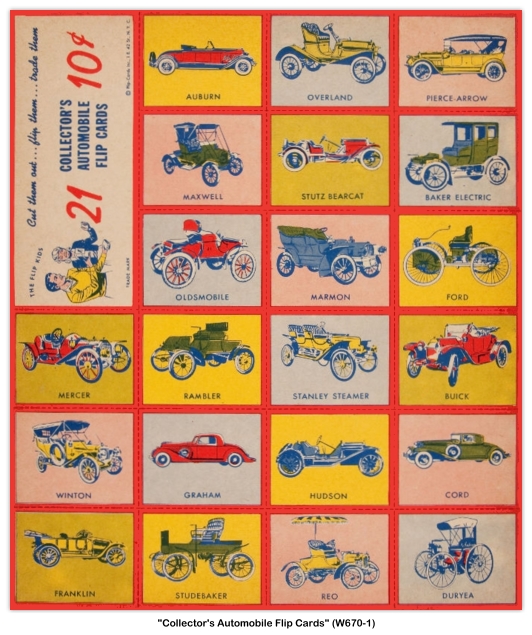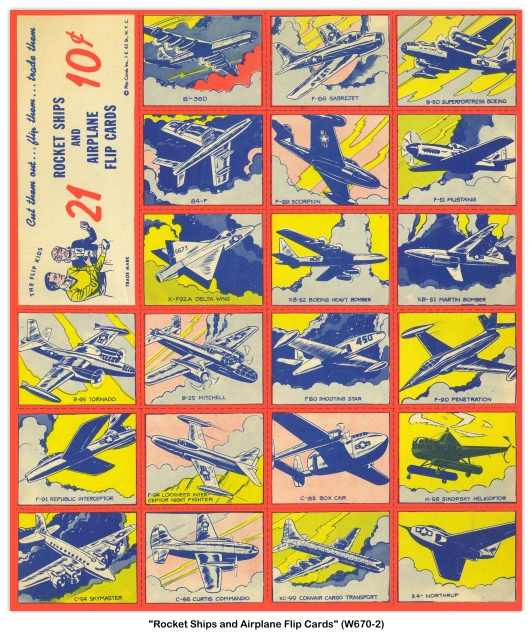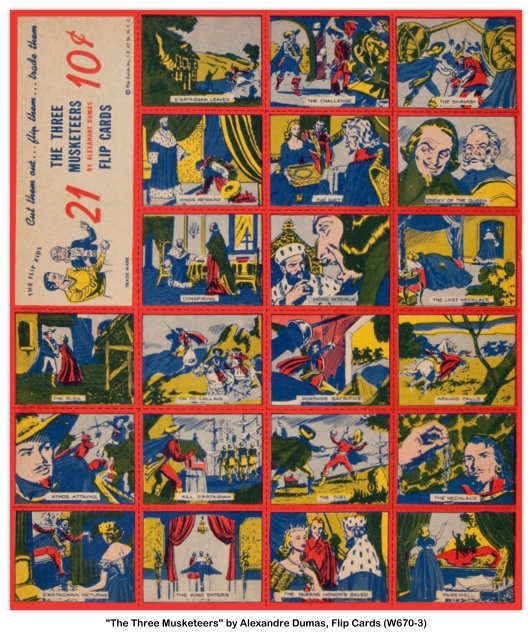
| ||||
|---|---|---|---|---|
 |
 |
 |
 |
 |



























| ||||
|---|---|---|---|---|
 |
 |
 |
 |
 |


























1951 “A Trip Around the Moon” (W670-4)
Flip-Cards, Inc., New York City, USA
Series Title: “A Trip Around the Moon”
Manufactured by: Flip-Cards, Inc., New York City
Country: United States
Number of Cards: 21
Numbering: 1 to 21
Cut Card Dimensions: 2.77 × 2.16 inches
Uncut Sheet Dimensions: 11.08 × 13.00 inches
Circa: c.1951
Overview [2]
During the early 1950s, Flip-Cards, Inc. issued a series of four 21-card uncut sheets of collector cards. Each uncut sheet, measuring 11 × 13 inches, consisted of a set of 21 cards. Each individual card measured 2.77 × 2.16 inches (nominal). The card fronts featured 4-color artwork (red, yellow, green and blue) surrounded with a thin dark border line and a red exterior border. A standard “cut here” dash line separated the individual cards. The cards were mean to be hand-cut. The title panel (using three card spaces) was located in the top left corner of each sheet. The title panel included the set name, and an issue price of 10¢. Additional text reads “Cut them out … flip them …” trade them and includes an illustration of a boy and girl known as “The Flip Kids”. The four Flip Card sets are shown below.




The backs of the cards are printed in a light blue ink on gray card stock. The card backs contain a simple text description of the subject card. The American Card Catalog reference numbers for the above sets are W670-1, W670-2, W670-3 and W670-4 respectively.
“A Trip Around the Moon”
The Plot [1]
Having been fired out of the giant Columbiad space gun, the Baltimore Gun Club’s bullet-shaped projectile, along with its three passengers, Barbicane, Nicholl and Michel Ardan, begins the five-day trip to the moon. A few minutes into the journey, a small, bright asteroid passes within a few hundred yards of them, but luckily does not collide with the projectile. The asteroid had been captured by the Earth’s gravity and had become a second moon.
The three travelers undergo a series of adventures and misadventures during the rest of the journey, including disposing of the body of a dog out a window, suffering intoxication by gases, and making calculations leading them, briefly, to believe that they are to fall back to Earth. During the latter part of the voyage, it becomes apparent that the gravitational force of their earlier encounter with the asteroid has caused the projectile to deviate from its course.
The projectile enters lunar orbit, rather than landing on the moon as originally planned. Barbicane, Ardan and Nicholl begin geographical observations with opera glasses. The projectile then dips over the northern hemisphere of the moon, into the darkness of its shadow. It is plunged into extreme cold, before emerging into the light and heat again. They then begin to approach the moon’s southern hemisphere. From the safety of their projectile, they gain spectacular views of Tycho, one of the greatest of all craters on the moon. The three men discuss the possibility of life on the moon, and conclude that it is barren. The projectile begins to move away from the moon, towards the ‘dead point&rsdquo; (the place at which the gravitational attraction of the moon and Earth becomes equal). Michel Ardan hits upon the idea of using the rockets fixed to the bottom of the projectile (which they were originally going to use to deaden the shock of landing) to propel the projectile towards the moon and hopefully cause it to fall onto it, thereby achieving their mission.
When the projectile reaches the point of neutral attraction, the rockets are fired, but it is too late. The projectile begins a fall onto the Earth from a distance of 160,000 miles, and it is to strike the Earth at a speed of 115,200 miles per hour, the same speed at which it left the mouth of the Columbiad. All hope seems lost for Barbicane, Nicholl and Ardan. Four days later, the crew of a US Navy vessel USS Susquehanna spots a bright meteor fall from the sky into the sea. This turns out to be the returning projectile, and the three men inside are found to be alive and are rescued. They are treated to lavish homecoming celebrations as the first people to leave Earth.

As shown above, the “A Trip Around the Moon” 21-card Flip-Card set was not issued as single cards, but as an uncut sheet of 21 cards with a three card advertising panel. The uncut sheets were purchased for 10¢ from local 5¢ & 10¢ stores. The following advertising copy is from the advertising panel.


Image-Guide [2]


The following “A Trip Around the Moon” (W670-4) Image-Guide was developed from a series of low-grade scans that were obtained from various sources on the Internet. Subsequently, we do not have any 600-dpi images associated with this set. However, we were able to generate computer enhanced images of the 21 card fronts, but were unable to generate only one card back image. Therefore, the following card images are presented in a logical sequence, while the actual card numbers need to be validated. Any help would certainly be appreciated.





















Checklist
Unfortunately, the checklist for the set has not been validated. Card #8 - “The Canon” was the only reference card that we had.
| A Trip Around the Moon (W670-4) Flip-Cards, Inc. Checklist | ||
|---|---|---|
| № | x | Card Title |
| 1 | Gun Club | |
| 2 | A Meeting Is Called | |
| 3 | A Proposal | |
| 4 | The Experiment | |
| 5 | Three Will Go | |
| 6 | The Money Is Raised | |
| 7 | The Moon Is Sighted | |
| 8 | The Cannon | |
| 9 | The Space Projectile | |
| 10 | The Interior | |
| 11 | The Telescope | |
| 12 | Sighting the Moon | |
| 13 | A Test Is Made | |
| 14 | Flight of the Silver Bullet | |
| 15 | Goodbye Earth | |
| 16 | In Flight | |
| 17 | Lost in Space | |
| 18 | Celestial Fireworks | |
| 19 | Off Course | |
| 20 | A Flaming Meteor | |
| 21 | The Rescue | |
| n/a | 21-card panel “A Trip Around the Moon” | |
References
